Table of Contents
–Statistics: which ones matter
- The Gorge Jump
- Toads Factory Lake Cut
- DK Summit Double Cut
- Grumble Volcano Rock Hop and Respawn Shortcuts
- Dry Dry Ruins Wall Glitch
- Bowser’s Castle Glitch
- The Moon Jump
- Delfino Square Double
- DK Mountain Glitch
What is Mario Kart Wii?
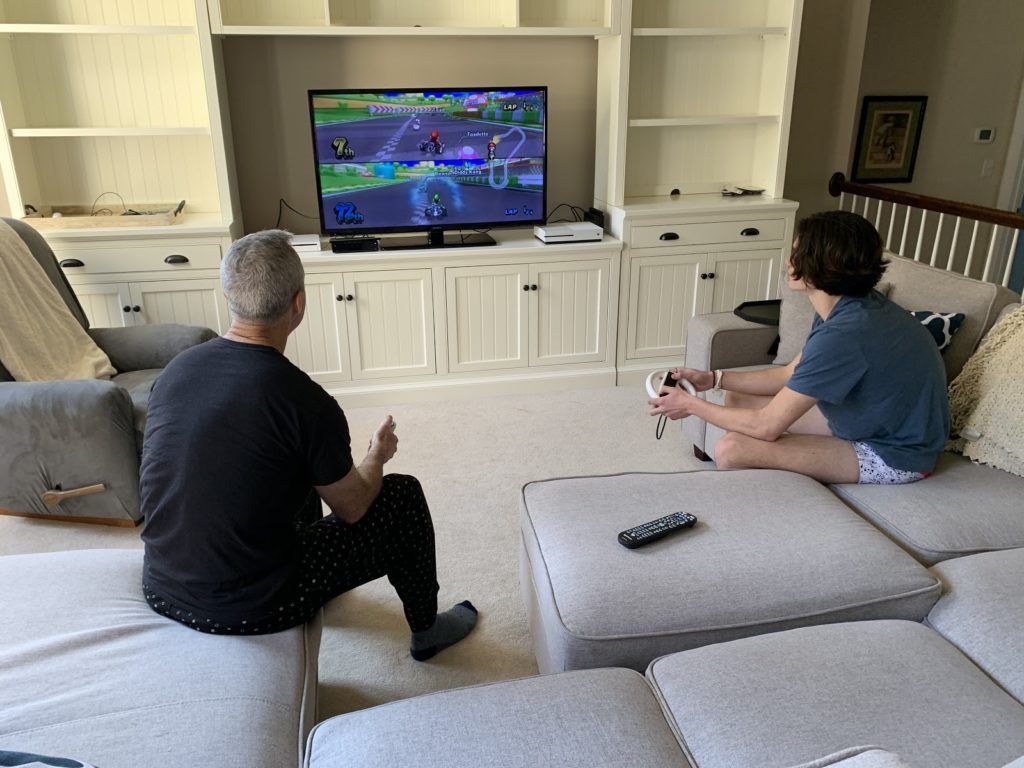
No matter if you are in 1st place or 12th place, Mario Kart still provides great family fun. Pictured are Terry Fleming on the left and Patrick Fleming on the right.
Mario Kart is a series of go-kart-style racing video games where players select characters previously seen in the Mario Bros. games, like Mario, Luigi, or Bowser, while also using various items to gain an advantage and win the race. Mario Kart is a multiplayer game that is a chaotic, action-packed, and easy to control the game, but it’s also something people with different skill levels can enjoy together.
The first of the Mario Kart series, Super Mario Kart, was released for the Super Nintendo Entertainment System in 1992. Shigeru Miyamoto, a Japanese video game designer who created the original Super Mario Bros, as well as many other successful games for Nintendo, oversaw the development of the first game
With six Mario Kart games released on home consoles, three on portable handheld consoles, four arcade games co-developed with Namco, and one for mobile phones, the Mario Kart series includes a total of fourteen versions. The latest game in the main series, Mario Kart Live: Home Circuit, was released on Nintendo Switch in October 2020.
Mario Kart Wii is also developed and published by Nintendo for the Wii. It is the sixth installment in the Mario Kart series and was released worldwide in April 2008. Mario Kart Wii is bundled with the Wii Wheel accessory to create a more realistic driving experience.
To play the game, one must first choose a character that will be their racer. Mario Kart mainly features characters from the Mario franchise. Players can also select a character from other game series, including The Legend of Zelda, Animal Crossing, and Pac-Man.
The decision on what player to choose is tricky because there are many potential character abilities, karts, and tire configurations that all have widely varying stats across a number of attributes. Some setups are notably better than others. Setups like Funky Kong with the Flame Runner or Daisy with the Mach Bike reign supreme over most other combinations.
One of the features of the series is the use of various power-up items obtained by driving into item boxes laid out on the course. These power-ups include mushrooms to give players a speed boost, Koopa Shells to be thrown at opponents, banana peels, and fake item boxes that can be laid on the course as hazards.
The type of weapon received from an item box is influenced by the player’s current position in the race. For example, players lagging far behind may receive more powerful items, such as Bullet Bills which give the player a bigger speed boost depending on the place of the player, while the leader may only receive small defensive items, such as shells or bananas.
This gameplay mechanism allows other players or computers a realistic chance to catch up to the leading player. They can also perform driving techniques during the race such as rocket starts, slipstreaming, and mini-turbos.
Mario Kart allows friends to play against each other, on the same screen in the most simple and pleasing way. There are no gear changes or special appreciation of cars needed, no special compound of tires, no setups or racing lines. You simply select your character and go about racing on many great tracks like Mushroom Gorge or Rainbow Road.
Friends and families love Mario Kart because the game has been so good at capturing enjoyment with multiple players able to play in the same room at the same time. It creates chaos, it creates fun and it creates memories.
Leesville students often find Mario Kart Wii fun to play because of the childhood nostalgia that it brings. Many grew up playing the game on the Wii with friends and family and with the new consoles being released it is bringing many back to the game–reminding them of their once-lost love.
It’s quick, it’s fast and it’s rewarding. You can leap between games, courses, and players very easily, you have a large variety of courses and visually interesting areas. You have the nostalgia of older games reimagined and long-loved characters to choose from.
Mario Kart is the best casual racing game. It is the most accessible to everyone, young or old, racing professional or complete stranger. It will bond people, create stories, and has an everlasting appeal because it’s simple, it’s short and it’s exciting. The game includes a lot of mechanics and cool history that many casual players do not know about.
Strategy Guide
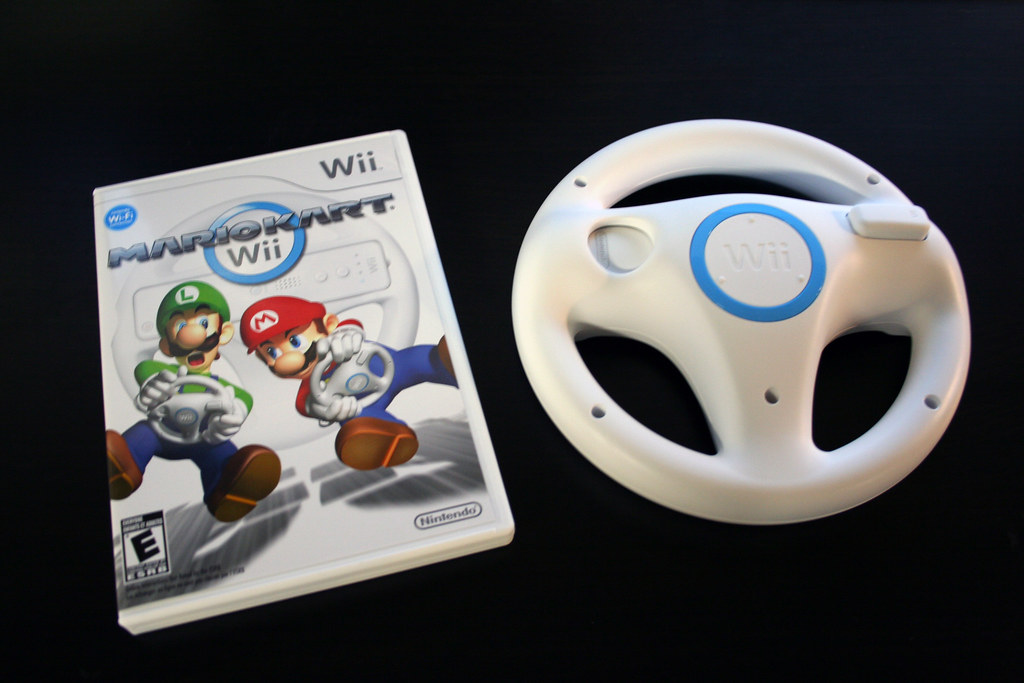
Mario Kart Wii is packed full of cool strategies and mechanics. Using these to your advantage can optimize your driving to levels you may have not realized before. (Photo Used from Public Domain)
Mario Kart Wii is a classic game that a lot of high school students can remember playing on old Wii consoles in their youth. However, most people are not very good at the game and do not understand all of the mechanics and physics of the game, but if they did they would have a big step up on their friends.
Choosing a Controller
Believe it or not, there are multiple ways to play Mario Kart Wii. The most known way is with the Wii wheel which uses the Wii’s motion sensor to control the kart by turning the wheel side to side. However, the player can also play with a nunchuck that plugs into the Wii remote and allows the player to steer with the joystick instead. The final common way of playing is with a classic controller or a GCN controller, these controllers do not use any of the motion tracking abilities.
Most commonly, casual players choose to use the Wii wheel/motion controls to play Mario Kart Wii, however, this is not an optimal way to play the game. The Wii came out in 2006 and its motion tracking abilities are, to put it simply, very outdated. It is very easy to have the controller turn the wrong way, or not wheelie or trick when the player intends, making the controller rather frustrating to play with.
The most common control style for more advanced players is using the Wii remote and a nunchuck. This is very easy to set up, as the player just has to plug in the nunchuck to the controller before playing and has loads of benefits.
The use of the joystick makes turning way easier and takes away the potential of false inputs. It only relies on the Wii’s motion controls to wheelie, and since the motion tracker is only looking for the controller to jolt upwards for a wheelie and not anything else it is much more reliable.
The final way of playing is with a Classic or GCN controller. Although this completely eliminates the use of the Wii’s motion sensor, it does cost money to order one online and it does not make too much of a difference from just using the Wii remote and a nunchuck.
Overall, most casual players should use a Wii remote and a nunchuck because of its solid control options and easy access. However, if you want to play as optimally as possible and do not mind spending a few extra bucks buying a Classic or GCN controller could be a good option.
Characters and Karts and why They Matter
One of the first things a player does after loading up the game is selecting their character and the vehicle they want to race with. Most people do not particularly care about their character or vehicle, but choosing the right ones are vital to having a good race.
Statistics: Which ones Matter
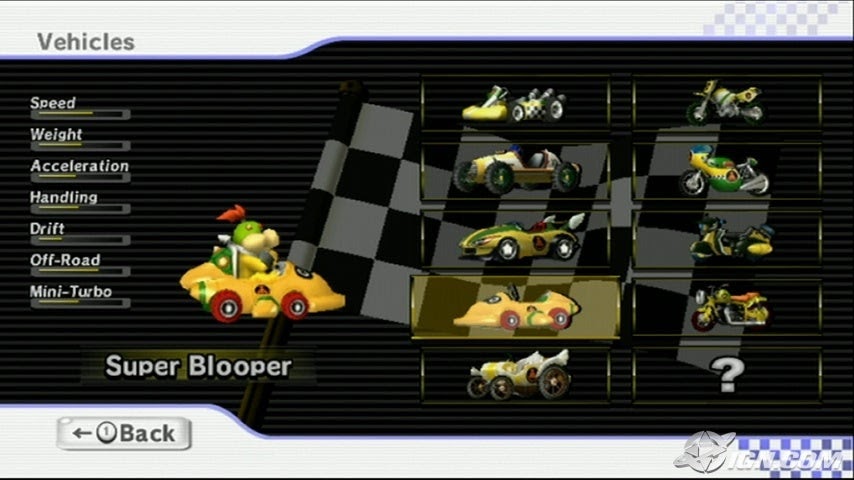
Characters and vehicles combine to the overall statistics (stats) a player will have when racing. It is important to remember the goal of the game when considering what stats are important. The player wants to get to the finish line as quickly as possible by any means necessary.
Therefore, the most important statistic by far is speed. It is common sense that in a racing game the player wants to go fast, so having a combination that emphasizes speed is important.
Next on the list is drift. The drift stat allows for the driver to take tighter turns and travel a shorter distance because of it. Traveling fast does not matter if you have to travel twice the distance because you could not take a turn tight.
After drift, there is a slight drop off in importance as you arrive at mini-turbo. When a player chooses manual drifting, (which they should because it is far superior to automatic in most cases) they can charge up a mini-turbo boost when they turn which will propel the player forward at a great speed for a short amount of time. Mini-turbo can lengthen this boost and can be very helpful especially on tracks with a lot of long turns.
After mini-turbo is the off-road stat. The off-road stat allows for faster travel through patches of grass or other surfaces that are on the sides of the track. This stat is very helpful for new players who may struggle to stay on the track, but it can be crucial for certain tracks with a lot of off-road like Sherbet Land and Shy Guy Beach.
The final somewhat useful stat is weight. Weight determines the interaction between two vehicles when they collide in multiplayer races. This stat is mainly beneficial when trying to sabotage someone else or trying not to get sabotaged by others, but in the case of trying to go as fast as possible, it does not matter much.
After weight, there is a large dropoff in viability. The final two stats, acceleration and handling, are somewhat useless.
You might be thinking, “But what if I hit something and lose all my speed? Acceleration is important,” and that is where you are wrong. If you selected manual drifting (which you should have), you are able to create a “stand-still mini-turbo” which, as the name implies, is a mini-turbo that the player charges up at a stand-still.
Charging up this mini-turbo takes around two seconds, but boosts the player right back to top speed instantly. This is faster than accelerating normally for most viable vehicles excluding the lightweight ones with very high acceleration like the Quacker or Magikruiser. Most of the time the vehicles that do have a high acceleration do not have enough speed to utilize that high acceleration and maintain a lead.
The final stat is handling… handling does nothing for most players. If you are using manual drift, handling affects how steeply you can turn when you are not in the action of drifting.
Characters
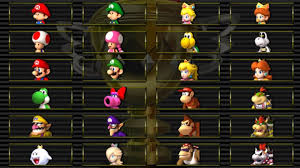
There are three different types of characters in Mario Kart Wii. Lightweights, middleweights, and heavyweights. Rows separate the three types and they are pretty easy to tell apart. The top two rows of characters are lightweights, the middle two rows of characters are middleweights, and the bottom two rows of characters are heavyweights.
The weight class of the characters determines which vehicles they will be able to select. There are 10 unique vehicles for each weight class and two universal vehicles (the standard kart and standard bike). The vehicles in the lightweight class tend to favor acceleration, off-road, and handling, but lack in speed and weight in most cases.
The middleweight vehicles, as the name suggests, do not favor one set of stats but have a more even spread across all of the vehicles.
The heavyweight vehicles tend to favor speed and weight, but lack in off-road and acceleration.
Within each weight class, certain characters have hidden stat bonuses. Speed is the most important stat bonus because speed is the most important stat. Therefore, the best characters for each weight class are:
- Baby Daisy for the lightweights (has the same speed bonus as Baby Luigi but better mini-turbo bonus)
- Daisy for the middleweights
- Funky Kong for the heavyweights
These hidden bonuses and not known by a lot of casual players, so it is easy to get a slight edge by knowing the hidden stats for each character.
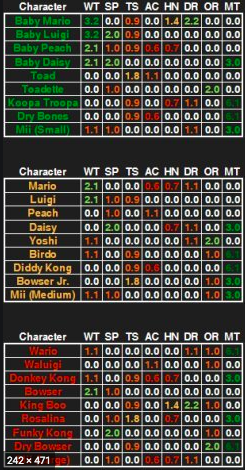
Vehicles
In Mario Kart Wii, there are two types of vehicles, bikes and karts, and there are a few distinct differences between the two.
To start, Karts can charge up a “super mini-turbo” which is a longer version of a regular mini-turbo that takes longer to charge up but gives a much better boost. When the kart drifts the first blue sparks are just a normal mini-turbo that does not take long to charge, but later orange sparks will appear and that is the super mini-turbo.
On the other hand, the bikes can only charge up a regular mini-turbo with blue sparks, but bikes have the option of wheelieing. When a bike wheelies on a straight-away, it can travel 33% faster than normal– which is insane. However, when a bike is wheelieing it cannot turn much at all and if the player tries to turn it, the bike’s speed decreases. Another thing with the wheelie is if another player bumps a wheelieing player, the player in the wheelie will lose most of their speed and will slow down drastically.
However, the biggest difference and the most crucial difference between the two is that bikes have the potential to have inside drift. There are two types of drifting in Mario Kart Wii, outside drift and inside drift. All karts and about half of bikes have outside drift, while the other half of bikes have inside drift.
Outside drift is where the vehicle swings out its back tires when it turns as seen on the left side of the image below. This causes the vehicle to take very wide turns and overall is drastically slower than the alternative.
Inside drift, on the other hand, is where a bike cuts immediately into a turn when performing a drift as seen on the right side of the image below. This allows for the bike to take much tighter turns than an outside drifting one.
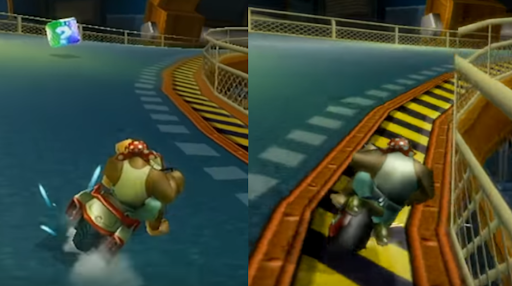
With the abilities of inside drift and wheelieing, inside drifting bikes outclass karts and outside drifting bikes on just about every front. inside drifting bikes own every single world record except one. The one exception is Rainbow Road no ultra shortcut by Flare in which Flare is able to get a larger moon jump shortcut at the beginning of the race with a kart and hold on to the lead ahead of any inside drifting bike runs.
The Best Combinations
When playing multiplayer or competing in most time trials, the best vehicle character combination by far is Funky Kong and the Flame Runner. This combination grants the player a great amount of speed, a very good amount of drifting, and the ability of inside drift. The vehicle’s versatility is almost unrivaled as it excels in just about every track. This combination is everywhere in multiplayer races and holds 13/32 of the current world records in the game.
Just behind Funky Kong and the Flame Runner is Daisy and the Mach Bike. This combination also has a decent amount of speed–not quite as much as Funky Kong and the Flame Runner but close–however, it stays viable because of its phenomenal drift stat. This combination is great on tracks with a lot of tight turns and boasts 6/32 world records.
Other bike combinations include:
- Funky Kong and the Spear–which tops out as the fastest vehicle in the game when wheelieing but lacks in drifting abilities–holding 8/32 world records,
- Baby Daisy and the Bullet Bike–which boasts a great amount of speed and a greater drift than that of the Mach Bike–and holds the Waluigi Stadium world record
- Toadette and the Magikruiser–known for its legendary off-road stat–holding a world record on Sherbet Land and contends for the world record on Shy Guy Beach.
Although inside drifting bikes are much better than karts, some people prefer to drive karts. Some good combinations for karts include: Funky Kong and the Flame Flyer, Daisy and the Wild Wing, and Baby Daisy and the Mini Beast.
Automatic vs Manual Drifting
After selecting your vehicle and character, the game will ask if you would like to use automatic or manual drifting. As touched on earlier in the article, manual drifting is far superior to automatic in most cases.
In automatic drifting, as soon as the input to turn sharply registers, the vehicle will start to drift. However, in automatic drifting, you cannot charge up a mini-turbo. This is a good option for those just starting the game because it is easier to control, so if you or any of your friends are just starting the game automatic drifting would be a great place to start.
Manual drifting, on the other hand, does not start drifting with just a simple input on the joystick or turn of the wheel. Instead, the player must hop (with the B-button on the Wii-remote or R on the controller), and then turn while in the air of the hop to perform a drift. If the player fails to start the turn while in the air, the vehicle will turn very slowly, but if the player succeeds the drift will charge up a mini-turbo which grants a speed boost.
Manual drifting is best in almost every situation, however, the Peach Gardens world record uses automatic because of the complex bush maze that is spaced awkwardly for trying to manually drift on.
Physics
Before we get into the different strategies for how to drive faster, it is important to understand the physics of Mario Kart Wii.
Airtime
In Mario Kart Wii, flying through the air–although flashy and cool–is almost always slower. When you are in the air, you lose speed and end up traveling a lot slower than you would if you were on the ground.
Typically, attempting to get “low tricks.” To perform a trick, the player must flick the Wii remote or hit an arrow on the directional pad on the controller when driving off a ramp; tricks cause the character to do a flip or something along those lines in the air which gives more air time but also gives the player a speed boost once they hit the ground. Low tricks (which will be explained later) are tricks that have less air and are optimal on most ramps.
Bounciness
Mario Kart Wii has a lot of strange terrain on its tracks, a lot of this terrain can cause the player to get pockets of air in weird spots.
For example, on tracks like Dry Dry Ruins, players must account for a lot of very bouncy terrain that creates a great number of small pockets (or even big pockets) of air throughout the course. At the end of the track, there is a weird slope that gives so much air that it creates an unintended shortcut by bouncing over a sand dune.
Mushroom Physics
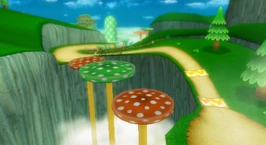
Players see mushrooms throughout courses like Mushroom Gorge, and for those who play on custom tracks, they are very common.
There are five parts of mushrooms that each give different jump heights: the center, the slope, the dip, the perimeter, and the edge.
The center is the very middle of the mushroom, this gives the second highest bounce and is not commonly aimed for when trying to traverse across the mushrooms quickly, however, if you do end up bouncing here it does not matter much.
The slope is just outside of the center of the mushroom where the mushroom slopes downwards towards the lowest point on the mushroom. This gives the highest bounce and is only used when the player wants to travel a far distance in one bounce.
The dip is the lowest part of the mushroom and gives the second lowest bounce. This is the most commonly aimed spot on the mushroom because it is easy to aim for and gives a low bounce.
The perimeter is the outer surface of the mushroom and gives the third highest bounce. This is not typically aimed for but since it gives less of a bounce than the slope of the mushroom, it may be easier to aim for the outside of the dip so the bounce is not as high if you mess up.
The final part of the mushroom is the edge of the mushroom. This is the very side of the mushroom and grants a very low bounce if hit correctly. However, it is extremely hard to bounce on the edge and the precision required usually causes even the most experienced players to fall off, so it is really only attempted in tool assisted runs.
Drifting Strategies
One of the most important things to be able to do as a player is adapt to situations and know the optimal strategies for success. There are many different types of drifting strategies that are important to understand in order to be successful. These strategies, however, are only used with manual drifting.
Delay Drifting
“Delay drifting” is the most commonly used drifting technique and it is very important to get the hang of it. Delay drifting is used on almost every turn.
Delay drifting is when the player waits until just before touching the ground after a hop to input a direction to turn. When a player hops, they are airborne for 17 frames. Games run in frames per second (fps)–a frame is a single picture displayed on screen. The more fps the smoother the gameplay feels–Mario Kart Wii runs on 60 fps which means 60 times a second the game updates with a new picture. In order to delay drift, the player must wait to input the direction they want to turn in until as close to the 17th frame as possible.
Delay drifting allows the player to take turns sharper and get mini-turbos faster. This can make a big difference especially on tracks like GBA Bowser’s Castle 3, which has lots of short, sharp turns which are perfect to delay drift on.
However, delay drifting is not useful on every turn. Turns that require the player to hold a drift for a long time–past the time it takes to charge a mini-turbo but not long enough to release one and charge a second–are best driven by hopping and inputting a direction at the same time.
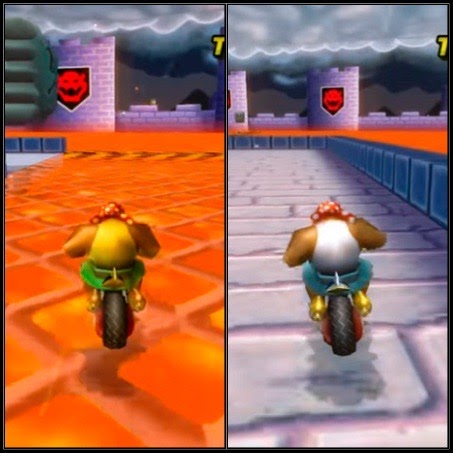
In order to know if you properly performed a delay drift, you can look at Funky Kong’s elbows. As seen in the picture on the right, when you do not delay drift, Funky Kong’s elbows will turn before hitting the ground, however, if you do delay drift properly, Funky Kong’s elbows will stay neutral until you hit the ground and start your drift as seen on the left.
Slip Drifting
Slip drifting is another drifting technique that can prove very useful. A slip drift is a type of drift that does not require a hop. The player can perform slip drifts after getting a pocket of air time due to uneven or bouncy terrain.
To perform a slip drift the player must input a drift as soon as their bike’s tires hit the ground. This will allow for the player to drift without wasting time hopping into the drift which loses time.
To know you successfully completed a slip drift, it should appear as if your bike stuck to the ground as it landed and started to drift.
Chain Drifting
A chain drift is a version of a slip drift in which the player can complete several drifts in quick succession. Some people also refer to this as a slip drift, but for simplicity’s sake, it will be referred to as a chain drift.
Chain drifting is a very difficult technique and requires very precise inputs. To perform a chain drift, the player must drift immediately after releasing a previous drift. So, the user must start a drift and charge up a mini-turbo, then release the drift button and immediately press it back down to start another drift.
You have approximately 4 frames to do this or about .06 seconds making it very difficult. To understand just about how fast this is, try to start and stop a stopwatch in this amount of time, it is very difficult.
To know if you pulled off a chain drift it should appear as if your character stuck to the ground while entering the second drift, instead of performing a hop like usual.
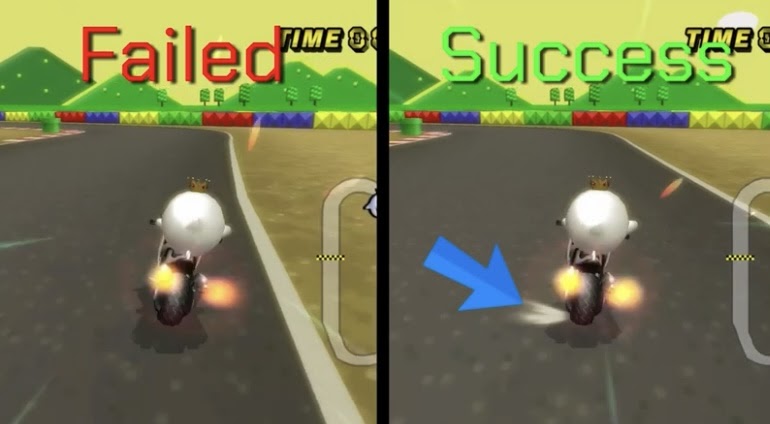
However, pulling off chain drifts can be very beneficial during the race as it allows the player to pull off more mini-turbos on a single turn and allows for faster driving overall.
Tricks and Low Tricks
To perform a trick the player must either flick the Wii remote or press one of the d-pad buttons as the character drives off a ramp. When a trick is performed, the character will perform a trick animation which could be a flip or a spin or something along those lines. A trick will give the player a boost when they hit the ground.
Although the boost given from tricks can be very beneficial, the extra air time that tricks give can make the boost negligible.
One example of a ramp where a trick is not needed is one Bowser’s Castle on the ramp leading into the long half-pipe section of the course.
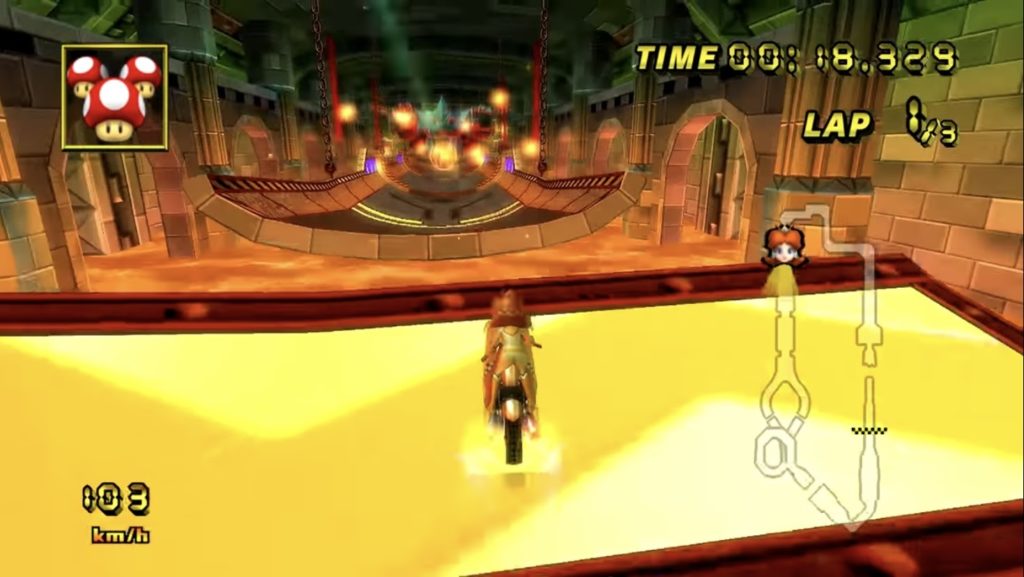
Although tricking normally will give the character more air off of ramps, there are ways to manipulate how the player will jump off a ramp and allow for lower air time called low tricks.
There are five different types of ramps that can be low tricked on and each have different strategies needed to perform the low tricks.
The first type of low trick is performed on bumper ramps, or short colored ramps that are shaped like a speed bump. These ramps are commonly seen on Bowser’s Castle 3 and Shy Guy Beach and look like short speed bumps rather than the usual large ramp.
These ramps are low tricked by hitting the hop button right before going off the ramp and tricking. Essentially, you want your character to hop up to the ramp and trick in order to get low air.
The second type of ramp is the flat ramp. These ramps are seen on tracks like Coconut Mall, Wario’s Gold Mine, and Koopa Cape. These ramps are just flat ramps that are meant to shoot the player straight forwards with a boost panel.
In order to low trick these ramps, the player must hop right before they get to the ramp and just hit the very end of the boost panel with their back tire and trick. This will angle the player downwards and will give very little air as a result.
The third type of low trick is performed on certain ramps that do not have walls to either side. Examples of these ramps are on tracks like Moo Moo Meadows, Rainbow Road (however this is only really performed on TAS runs), and Coconut Mall.
These ramps are low tricked by aligning at a weird angle typically off the side of the ramp. These are sometimes called fall off ramps because the player essentially lines up on the ramp at the very edge and about to fall off but still gets the boost to perform a trick.
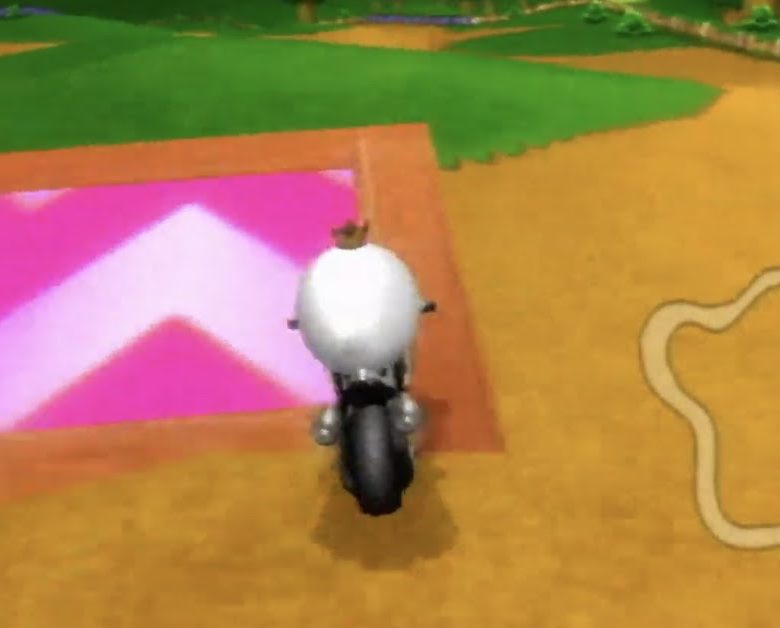
The fourth type of ramp is side ramps or ramps that are angled sideways. These are commonly found on Moonview Highway, Rainbow Road, and Coconut Mall.
These ramps can be low tricked off by hopping up and landing downwards on the ramp and then tricking with the downward momentum into the ground.
The fifth and final type of ramp is high ramps. These are ramps that angle the player high into the air and have walls to either side. This type of ramp is only seen on Waluigi Stadium, but there are a few custom tracks that also feature it.
In order to low trick these ramps, the player must angle their vehicle into the wall to the side and trick. When the player hits the wall, they will be immediately shot downwards towards the ground.
Wheelieing
When using a bike, wheelieing is essential to driving fast as it increases the players’ speed by 33%. A player should wheelie at every opportunity they get. The only time a player might not want to wheelie would be when they are in a pack of a bunch of players and do not want to get wheelie bumped which loses a lot of speed.
One thing to note is that on most ramps in which tricking is not beneficial, wheelieing off those ramps is the most optimal.
Chain Wheelieing
A chain wheelie is a hard strategy to pull off but can be very helpful on long straightaways on tracks like Luigi Circuit.
A chain wheelie is when a player starts another wheelie right as their previous wheelie runs out. A wheelie lasts three seconds in Mario Kart Wii and once it ends, the bike will drastically decelerate back to its original speed without wheelieing. Therefore, when the player tries to wheelie again, they will have to accelerate back to the wheelie’s top speed and overall lose time.
When the player pulls off a chain wheelie, the bike will only decelerate a tiny bit and will stay relatively close to top speed.
A good way to get the timing down to perform a chain wheelie is to listen for the “swishing” sound that occurs when the player wheelies. Right as the fifth “swish” happens the player should input another wheelie in order to get the most optimal chain wheelie.
Strategy Overview
Mario Kart Wii has a lot of different mechanics that can be hard to remember. However, there are a few key things that players must use everywhere in order to drive the most optimally.
First, always use inside drifting bikes, and unless you really do not want to, use Funky Kong and the Flame Runner or Daisy and the Mach Bike.
Second, wheelie whenever possible to maximize speed.
Third, delay drift on every turn and chain drift when you can.
Fourth, minimize air whenever possible, and if you can, low trick.
Finally, try to have some fun. Mario Kart is a very competitive game, but you will not be able to drive well if you get mad and break your remote.
Other Sources
https://www.youtube.com/playlist?list=PLzKpFz1DwMbi99zehrZENnosRG4r4W5jj
This is a YouTube playlist created by Mario Kart Wii Bootcamp that has a ton of different guides on how to do most things in Mario Kart Wii. The guides are short and very informative and I highly recommend everyone who wants to learn more to check them out.
Shortcuts to Know
Shortcuts are a classic part of Mario Kart Wii. They are used by everyday people and world record holders alike.
The Gorge Jump
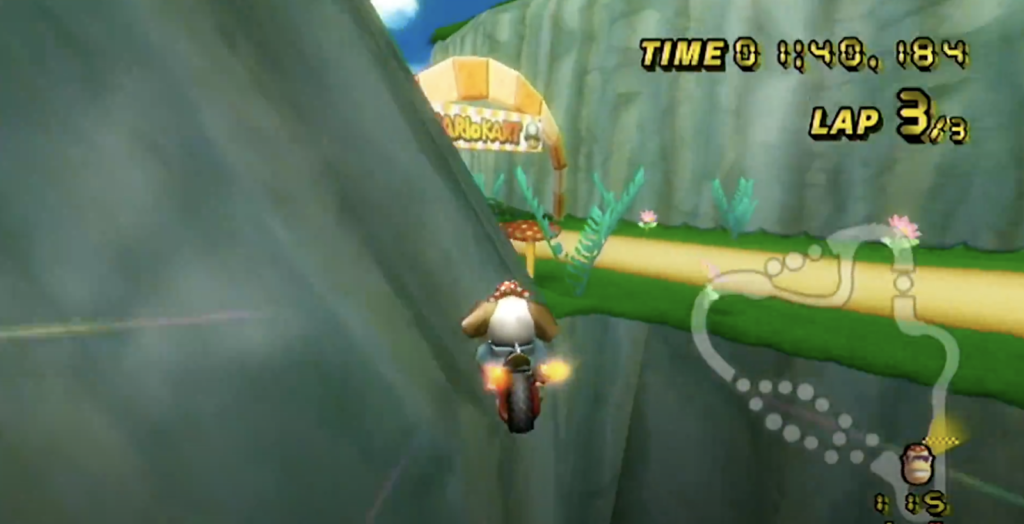
The Gorge Jump is the first shortcut we are going to cover today. It is on the Mushroom Gorge track near the start/finish line. To complete this shortcut, a player must align themselves on the left side of the gorge, then use a shroom boost to hop when they near the edge of the cliff. This will propel the players across the gorge, taking off at least a couple seconds and completing the Gorge Jump, a popular shortcut to take.
Toads Factory Lake Cut
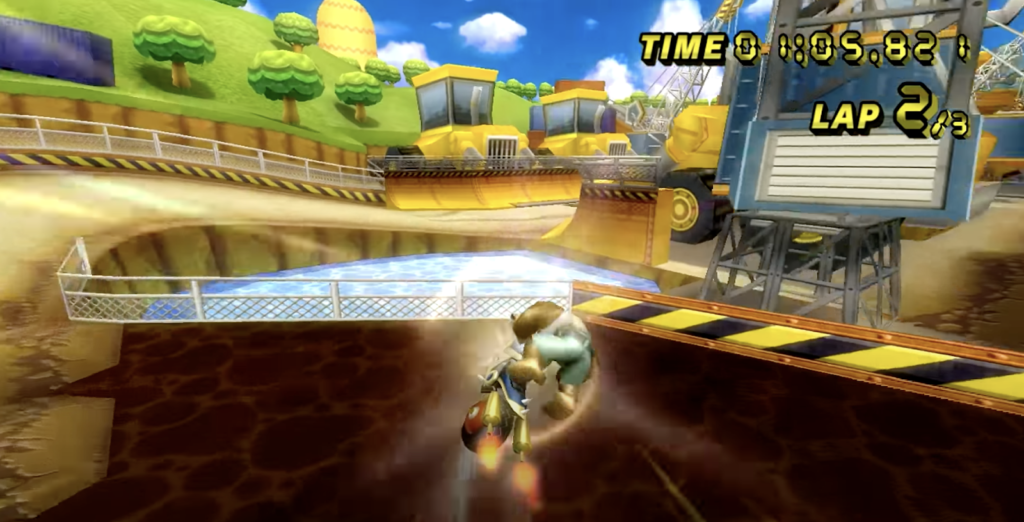
The Toad’s Factory lake cut is next. This shortcut is also near the start/finish line of the track. Going up to the lake, there are bumps on the track that allow a player to perform a jump boost by tricking off the ramp leading up to the shortcut. This allows the player to gain enough speed to be able to jump over the lake shown above instead of following the track around it. This shortcut can also be performed using a shroom boost in the same way the jump boost is used.
DK Summit Double Cut
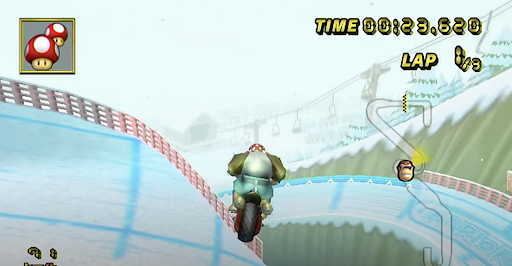
Pictured above is the DK Summit double skip shortcut. This shortcut results in a large cutdown of time and is very beneficial to players trying to set records. As the player approaches the large slaloms of the snowy track, the double skip can be performed by simply driving straight off the side of the cliffs, keeping close to the inside edges, avoiding the large turns and landing on the tracks below.
Grumble Volcano Rock Hop and Respawn Shortcuts
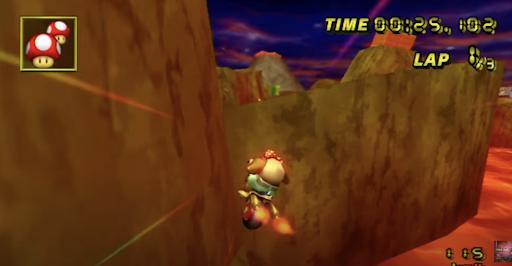
Shown above is the Grumble Volcano Rock Hop shortcut. This shortcut can cut off a lot of time on this course and will be found in the middle of the race. When approaching the main volcano, instead of going straight, players will jump off the side of the course shortly after exiting the cave section. Using their shroom boost, players will hit a rock wall and fall into the lava, respawning further up the course and therefore skipping a large portion of it. In another version of the shortcut, the player will use a shroom boost slightly further up the course than the previous shortcut and jump on a rock in the middle of the lava. The player will then drive across the rock to land further up the course.
Dry Dry Ruins Wall Glitch
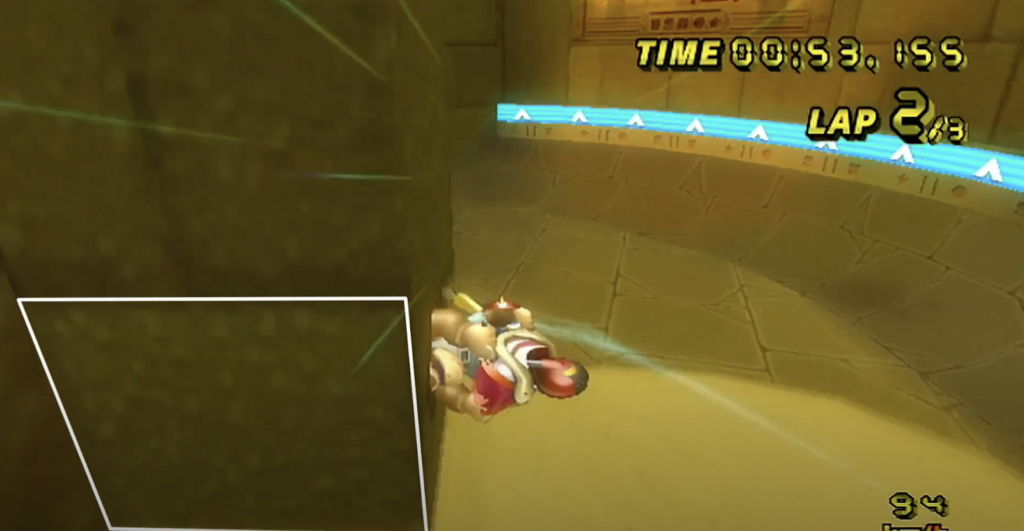
Next up is the Dry Dry Ruins Wall Glitch. This shortcut is found in the temple of Dry Dry Ruins. To use this shortcut, a player must drive up the very end of the blue zipper at a slight upwards angle and trick to jump boost into the wall. The shortcut allows the player to hug the wall tightly and take the turn a lot faster and more efficiently, saving a second or so of time on the track.
Bowser’s Castle Glitch
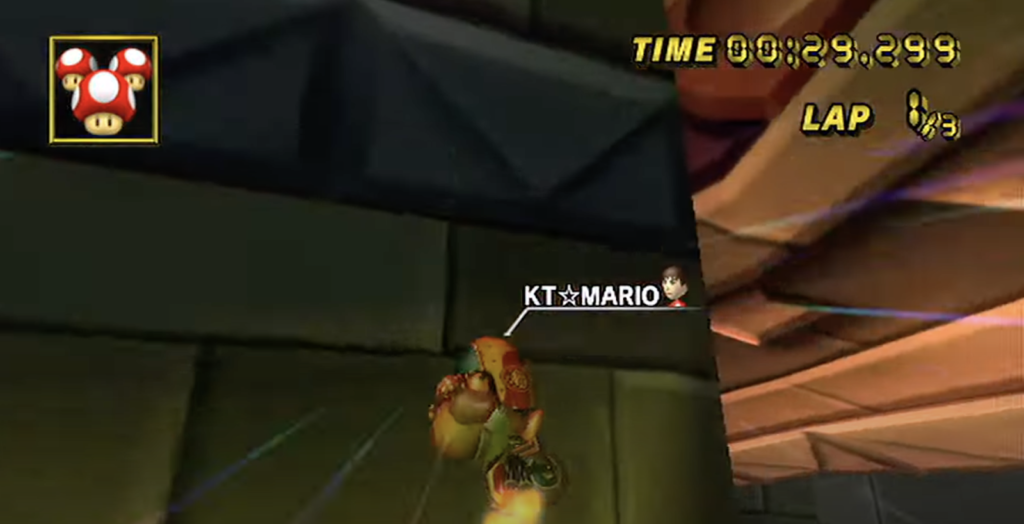
The Bowser’s Castle shortcut includes another wall glitch. This shortcut is also found in the middle of the track and allows players to use the blue halfpipe jump boost to skip to the next level of the castle. It is performed by aligning with the third screw on the right on the boost panels. The player will drive into the boost panel at that exact spot and shroom once they are in the air. There, the player can continue with the typical route, cutting time by jumping through the wall glitch rather than going up stairs and multiple turns to make it to that same location.
The Moon Jump
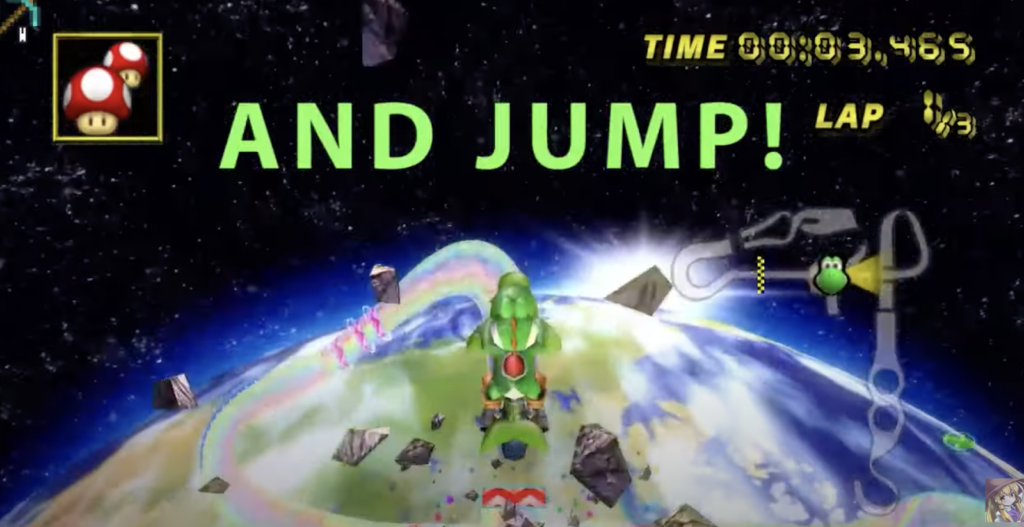
Pictured above is the Rainbow Road Moon Jump, a shortcut that requires a lot of precision. To reach this right after the start/finish line, players must jump and shroom at exactly the fourth star after the first star poles on either side of the course. This will allow them to jump through the asteroids at the start of the track and land at the bottom of the hill with more speed and accuracy.
Delfino Square Double Cut
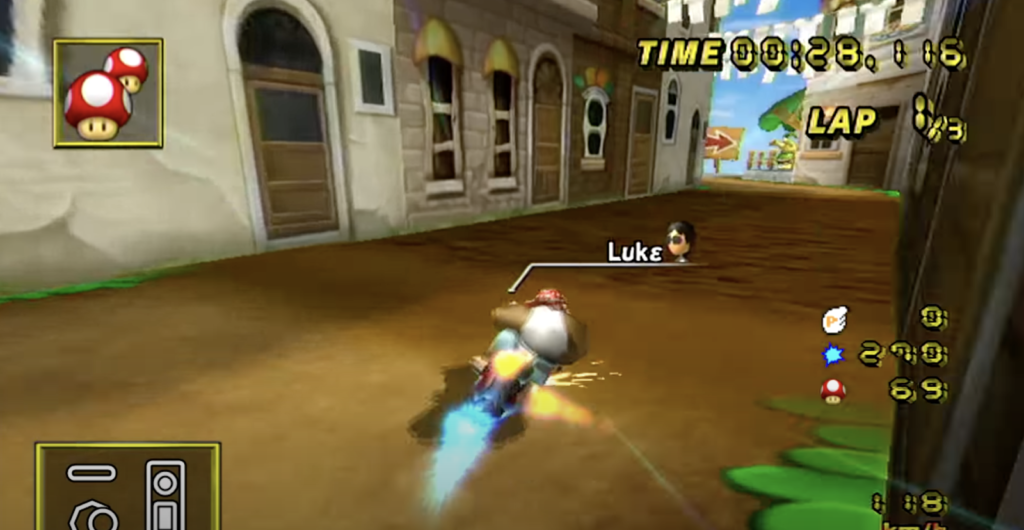
The shortcut pictured above is found on Delfino Square track. The double cut shortcut on Delfino Square track is a 2-part shortcut. After exiting the long plaza section of Delfino Square, to the left there is a ramp and a small patch of the grass. The player can use a shroom boost and trick off the ramp to reach the other side of the track across the river. Then, they use another shroom boost to fly through the offroad section pictured above. The offroad section is located near the start/finish line and can sometimes be hard for players to see. This double cut can save a lot of time in this course, as it provides multiple opportunities to shortcut the actual track and gain a competitive advantage.
DK Mountain Glitch
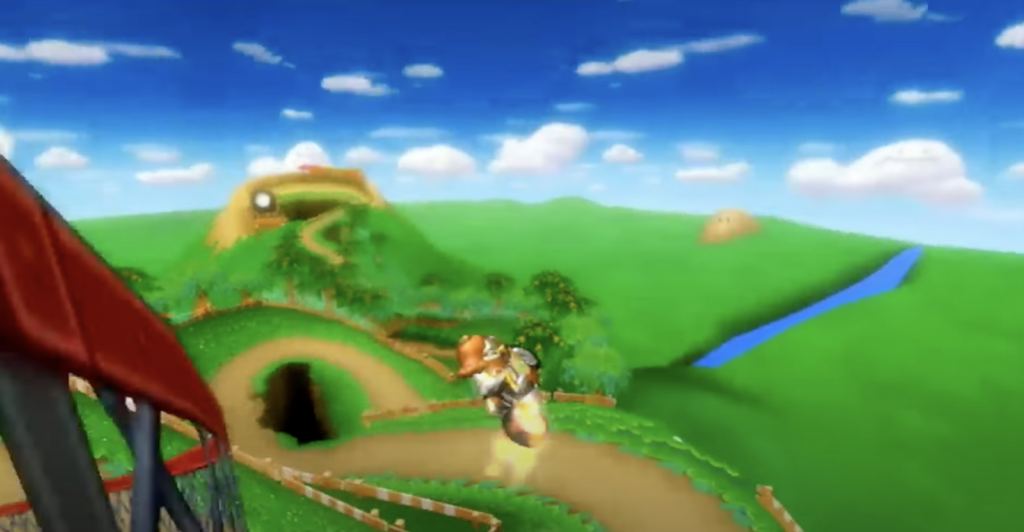
The DK Mountain shortcut glitch pictured above is found in the middle of the track. In this shortcut glitch, players must align where the blue zipper and silver fence meet (seen in the bottom left corner of the image). Then the player must shroom about a second before hitting the fence. As a result, players can skip the next two curves of the track and land below to save time with a direct route.
The Ultra Shortcut
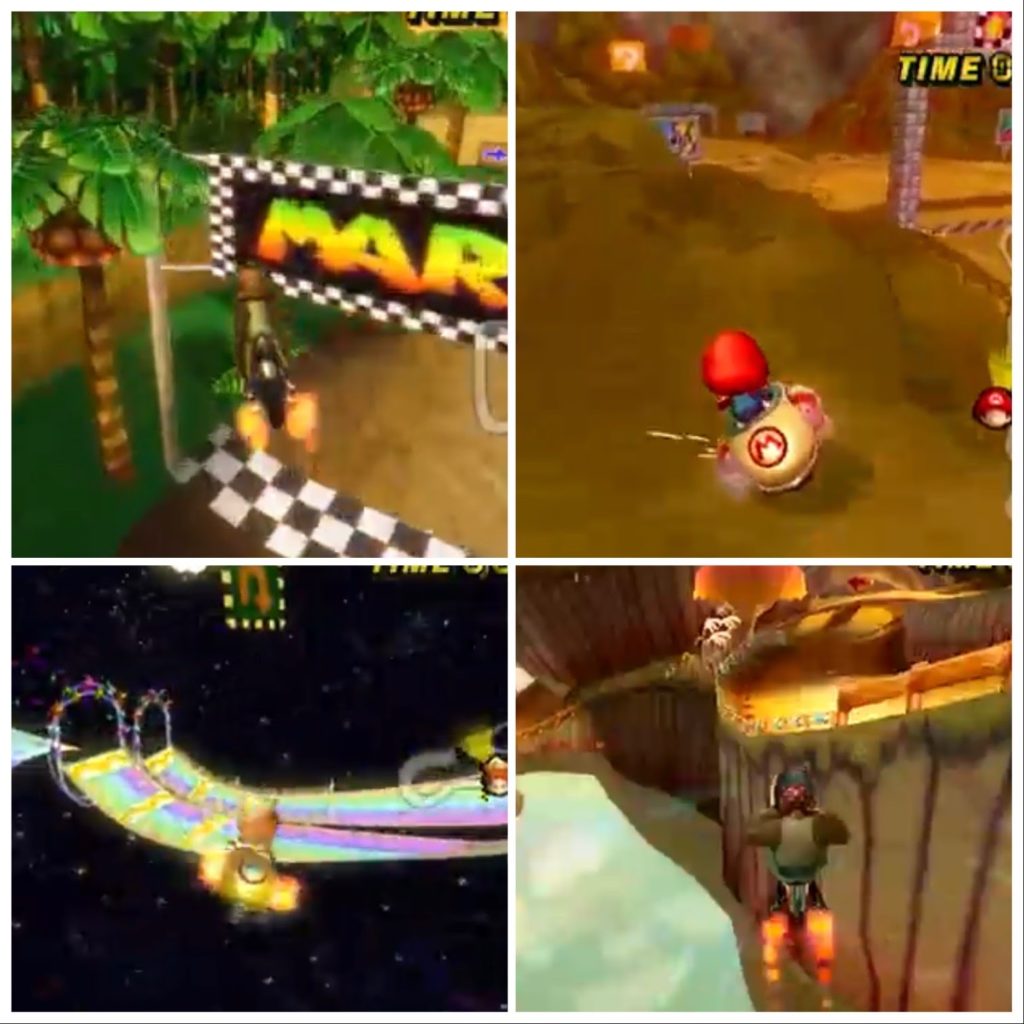
Ultra shortcuts in Mario Kart Wii are extremely interesting. The highflying, game breaking, extremely fast shortcuts are what separate Mario Kart Wii from other games in the franchise.
Mario Kart Wii is a notoriously broken game. On many of the tracks, players can complete huge jumps and skip a large amount of the track. These skips can make a track that usually takes around two minutes to complete beatable in less than 20 seconds. Players call these large skips ultra shortcuts.
How Ultra Shortcuts Work
There are 17 shortcuts within Mario Kart Wii and players complete all of them in very creative ways. Although all of the ultra shortcuts can seem wildly different, players perform ultra shortcuts by following a general formula.
Checkpoints
Every track has checkpoints. These checkpoints are where Lakitu will drop the character off when the player falls off the map. There are two types of checkpoints. Regular checkpoints and key checkpoints. Key checkpoints are the important checkpoints for ultra shortcuts because players need to cross them in order for a lap to count.
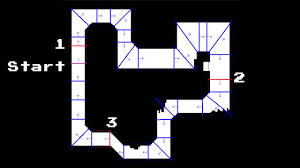
In the image above, the blue checkpoints are regular checkpoints and are only used to figure out where Lakitu will drop the player after they fall off. The red checkpoints are key checkpoints, and the purple checkpoint is the start/finish line which also counts as a key checkpoint (think of it as key checkpoint 0). The checkpoints are not just lines but boxes that extend forward to the next checkpoint.
In order for a lap to count, the player must drive through each key checkpoint in order. To track this (and also to reduce lag), the game only loads the key checkpoint directly in front of the player.
However, if the player is inside of a main checkpoint region, the game also loads the key checkpoint directly behind the player. This is what makes ultra shortcuts possible.
The Formula
Players are able to complete most ultra shortcuts with a similar formula. The player will start in checkpoint region 0 (the start/finish line box) and will skip in some way or another to a place further along the track. Since the game still thinks the player is in key checkpoint 0, the game loads the final key checkpoint because it is the checkpoint behind the start/finish line. So, when the player drives through the final key checkpoint, the game updates their position there and when the player drives through the finish line, the lap will count.
There are a few things to keep in mind:
- If the player drives across the finish line backwards, the game will subtract a lap so when they drive back across the finish line their lap count will remain the same.
- If the game suspects you skipped 95% of the course at one time, the lap will not count. Most of the time this rule does not matter/apply, but on some courses like Sherbet Land, it ends up making all the difference.
- If the player tries to do an ultra shortcut in a checkpoint box outside of checkpoint region 0, the lap will not count because the game has not loaded checkpoint region 4.
- If the player does not cross the final key checkpoint before crossing over the start/finish line, the lap will not count.
The Origins of the Ultra Shortcut
Players discovered the first ultra shortcut shortly after the game’s release on June 1, 2008 on the track Grumble Volcano. The shortcut was very simple, and at the time, nobody knew how the trick actually worked, but it did work so many people set out to claim a world record of their own.
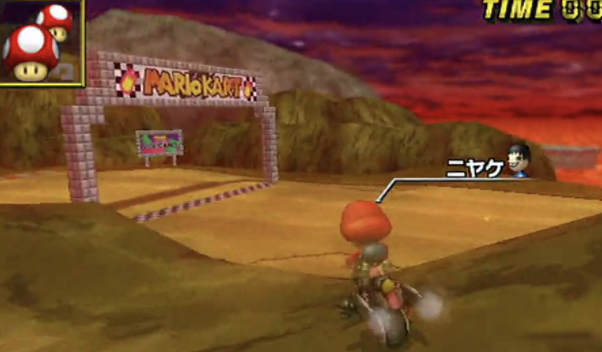
To perform this trick, the player must get onto this rock to the left of the start line typically by driving backwards and boosting off a ramp not far behind the start line. Then the player must drive around the edge of the rock formation. As the player drives around the rock formation, laps will count and the player can complete the course in under 20 seconds.
This works because the player drives into the start/finish checkpoint box by driving to the front of the rock, then out of the checkpoint box by going around the backside of the rock. Once the player reaches the back end of the rock, they will drive through the final checkpoint region and then straight forward across the closer side of the rock to cross the finish line and get a lap count.
Ultra Shortcuts Today
As of March 22, 2021, there are 17 total ultra-shortcuts in Mario Kart Wii. Some of these shortcuts are relatively easy and most people could perform them given a few tries. Some of the shortcuts, on the other hand, are extremely difficult and only a small sum of people have pulled them off. However, there are also a few ultra shortcuts that are humanly impossible and only a TAS (tool assisted speedrun) can perform them.
The 17 courses with ultra shortcuts are:
- Grumble Volcano — which is considered the easiest of all of the shortcuts, performed by driving around a rock to the side of the course as stated previously.
- Coconut Mall — a relatively simple shortcut involving driving off of an escalator ramp into a horizontal wall, then driving through the parking lot next to the finish line to get lap counts. (Horizontal walls have a weird property in Mario Kart Wii that when they are hit it allows players to drive through walls.)
- Mushroom Gorge — a decently hard shortcut involving turning around shortly after the start line and boosting off of the closest mushroom to the mountain, and riding the side of the mountain until you reach the other side of the finish line.
- DK Jungle Parkway — a tough shortcut involving a very strict alignment to wall clip off a tree and hit a horizontal wall on the top of the finish line, then fall through a cave and drive through it to finish the lap.
- Maple Treeway — a decently hard shortcut where the player hops onto the opposite side of the fence as the start/finish line, then shroom boost slightly left to land further up the track and skip key checkpoint 1. This makes the game think the player is still in region 0, so the player can take a large shortcut further up the track that otherwise would not count a lap on its own, but now it does because when the player updates their region by driving through the final key checkpoint.
- Mario Circuit — a shortcut involving wall clipping off a tree to a spot below the finish line, and since the finish line checkpoint box extends below the track the player can get lap counts by driving to the spot underneath the finish line and then driving through the last checkpoint and up to the actual start/finish line.
- Peach Beach — another wall clipping shortcut involves wall clipping off of a tree near the start line and landing on the beach further along the track, then driving the rest of the lap for a lap count.
- Rainbow Road — this shortcut is iconic in the Mario Kart Wii community and only one person, Arthur, has been able to pull it off since the tricks discovery years ago. This trick involves driving a little bit down the track then turning around and riding along the outside of the fence on the side of the track. Once the player enters key checkpoint 0 they spin drift to the right and use shrooms to boost over to the track on the opposite side of the course.
- Sherbet Land — there are two variations of this trick, the first is the respawn method where the player wall clips off of the start/finish line and has to land in a very specific part of the water to get the right respawn for the lap to count. The second variation involves landing back on the track after the wall clip, however, the trajectory the player must have is extremely specific and hard to get to work. Another thing to note is when the player does the second version, they have to drive a little bit forward up the track then back down in order for the 95% rule not to take away the lap count.
- Waluigi Stadium — this shortcut involves a very complicated series of events to get to work and only a very small number of people have completed it. First, the player must drive forward, turn around, shroom, drift, and trick off of the small ramp at the beginning of the track. Then the player will bounce off the top of the finish line and land on the track to the left, however, when the player lands on the left they must land on the very corner of the track so it causes them to bounce off and land back behind the finish line. Then the player must hop over a large gap and drive to the final key checkpoint and finish the lap.
- Wario’s Gold Mine — to perform this trick, the player must boost off of the side of the track and land on a pipe down below, if the player then will either bounce off the pipe and land back on the track or respawn behind the finish line. Either way, the player then drives backwards to the final key checkpoint and then finishes the lap.
- N64’s Bowser’s Castle — a very difficult shortcut that has only been pulled off once. This shortcut involves performing a barrel roll and then wall clipping in a very precise way off of the finish line pole and hitting the wall of the track further back. Then the player respawns behind the finish line where they would then hit the final key checkpoint and finish the lap.
- Shy Guy Beach — shortcut is very interesting as it does not save time overall on a race, but can save time on a singular lap. This shortcut involves wall clipping off of a bomb that a pirate ship shoots onto the course. There is a specific spot the bomb has to be, and it only occurs every four minutes or so. However, when it comes the player must wall slip off of it to jump over the deep water and land further back on the course. This allows for a very fast singular lap, but since it cannot be done until around the four minute mark, it is not faster overall for an entire race.
- Koopa Cape — to perform this ultra shortcut the player must glitch into the wall on the left side of the track towards the start line, then the player must drive up the wall a little bit, then shroom boost into a certain section out of bounds to get respawned behind the finish line and get a lap count.
- Mario Raceway — this ultra shortcut, similar to the Shy Guy Beach ultra shortcut, where it only saves time on one lap. Nobody has actually pulled this ultra shortcut off, but to perform it, they must glitch into the brick wall near the hairpin turn with the mushroom. Then the player has to slowly drive all the way up towards the finish line, turn around, boost out of bounds, and respawn to get a lap count.
- Dry Dry Ruins — this shortcut is humanly impossible and involves rapid fire hopping (pressing hop on every other frame to build up loads of speed), and shroom boosting off of a pillar ramp. This launches the player up and behind the finish line, so when the player drives back to the final key checkpoint and then finishes the lap, the lap will count.
- DS Peach Gardens — this is another humanly impossible shortcut that only saves time on one lap. It involves inhuman precision where the player has to drive through out of bounds sections of the course on tiny invisible stretches of land that are “in bounds” and eventually finish one lap, then boost out of bounds, respawn and drive to the final key checkpoint, then get a lap count.
Ultra shortcuts are fascinating and are being invented and optimized all the time. These game breaking glitches are what makes Mario Kart Wii so unique. They keep the game interesting and fresh, as there are always new barriers to conquer even for the best players.
Some Fascinating Speedruns
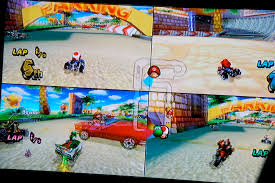
Mario Kart Wii is a popular wii game, consisting of different characters and karts that race against each other on courses. One particular feature of Mario Kart Wii is the speedrun setting, where players can set a time trial mode on the game to race themselves. (photo courtesy of Abigail Mabe)
Speedruns are a popular option of the video game Mario Kart Wii. Speedruns are when players can go into a Time Trial mode and make attempts to achieve the fastest times possible on singular tracks. When racers finish a race with a time they like, they will often save a replay of that race as a “ghost” which other players can view online.
Some of the most popular tracks for these speedruns are Mushroom Gorge, Wario’s Gold Mine, Coconut Mall, and Rainbow Road. Although the ultra shortcuts on these tracks save a lot of time, we will be looking into the non-ultra shortcut records.
The Mushroom Gorge non ultra shortcut record is 1:41.053 (1 minute and 41 seconds). This record of the Mushroom Gorge speed run was broken by a player named Lυkદ.
Lυkદ used the character Funky Kong and the Bowser Bike (flame runner). This is considered to be one of the best kart/character combos in the whole game that allows for maximum speed and control. He starts off by gaining the starting boost right off the bat, saving his three mushrooms of speed for later in the route.
He uses his jump boost trick on the first jump to cut through the grass without slowing down. There, he jumps the first two mushrooms (each of which give a boost if the remote is tilted the right way), and skips the third to land back on the track. Next, he heads into the cave and takes the lower route of mushrooms, using the jump boost trick on the first two mushrooms and the second to last, again skipping the last one to save time. Then, using one of the three mushroom boosts, he completes the larger version of the normal gorge jump by hugging the mountain a little tighter, ending his first lap in 33.793 seconds.
Lυkદ skips the mushrooms when he can to avoid excessive airtime, since airtime takes more time than racing on-track does in Mario Kart Wii.
Lυkદ uses the same strategy for his next two laps, getting the times of 33.651 and 33.609 for a total word record time of 1:41.053.
The Wario’s Gold Mine record is 1:50.601 (1 minute and 50 seconds). This record was broken by Vincent. Not surprisingly, he used the same combo as Lυkદ (Funky Kong and Bowser Bike).
Vincent starts off hugging each corner very tightly, using mini-turbos and wheelies at every opportunity to boost speed. He jumps once to skip going around a corner of the track before heading into the cave of bats. There, he uses his first mushroom boost to get up the large incline before jumping off the course to a lower part further along (he skips going all the way to the top of the hill to save time). Vincent uses his drifting as several mini-turbos around the tight corners of the track and takes the final shortcut of the smaller cave-like route next to the obvious track before the finishing lap.
Vincent achieves a first lap time of 36.937 seconds, staying consistent in his route to achieve times of 36.850 and 36.814 seconds for the next two laps.
The Coconut Mall speedrun record holds at 1:55.793 (1 minute and 55 seconds). This record was placed by the player Ace. Again, Ace used the same combo of Funky Kong and Bowser Bike to set this world record.
Ace begins the course as normal. He uses one of his mushroom boosts to speed through a store that cuts off a corner of the track, saving time. Then he jumps off the balcony to the main floor of the mall, using his jump boost trick as speed to continue up the rail of one of the escalators. He hugs the corners of the first tunnel, following the track as intended. However, when it comes to the third gray tunnel, he takes a right to stay on the same floor, jumping out the window with a boost to finish his first lap.
Ace’s lap times were all around the same: 38.515 seconds for the first, 38.663 seconds for the second, and 38.615 seconds for the third.
The Rainbow Road speedrun record without a glitch was set by a player named Flare with a time of 2:27.767. This notoriously tough track finishes off the Mario Kart Wii series and has little to no railings, making it a risky track to do jumps and tricks on. Interestingly, Flare used Funky Kong but a different kart for this track. He used the Flame Flyer kart, allowing for more control and balance over the edges of Rainbow Road. At the beginning of the Rainbow Road track, the moon jump skip with the extra corner cut is not possible on a bike, which is why Flare chose Flame Flyer instead of the classic Bowser Bike combo.
Flare starts off the Rainbow Road track with the classic moon jump, drifting sideways and skipping the first downward slope of track. Landing on the first boost panel, Flare holds his drift to cut a corner of the track to land on more boost panels. Staying tight to the next corner, Flare enters the next part of the track where jump boost tricks can be used consistently, and he speeds on to the circular jumps of Rainbow Road. Staying to the right part of the track, Flare hugs the sides and uses one of his three mushroom boosts to cut the next part of the track, landing on a straightaway and hugging the next corner until he reaches the star cannon.
Drifting is key for Flare on Rainbow Road, as he takes the lower path exiting the star path and uses the boost panel to jump a small gamp, landing on the upper path. He drifts again, hugging the corner of the last turn before the finish of lap one, completing with a time of 48.378 seconds. His second lap stays relatively consistent with a time of 48.289 seconds, finishing off with an amazing lap time of 48.100 seconds.